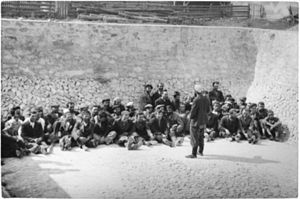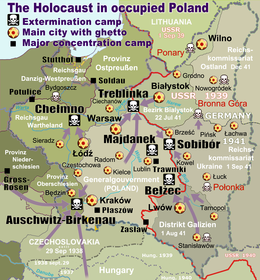Opatów Ghetto
| Opatów Ghetto | |
|---|---|

Jewish men assembled for slave labour,
Opatów, occupied Poland |
|
|
Opatów location during the Holocaust in Poland
|
|
| Location | Opatów, German-occupied Poland |
| Incident type | Imprisonment, forced labor, starvation |
| Organizations | Schutzstaffel (SS) |
| Camp | Treblinka extermination camp |
| Victims | 10,000 Polish Jews |
The Opatów Ghetto was a World War II ghetto set up by Nazi Germany for the purpose of persecution and exploitation of local Jews in the town of Opatów during the German occupation of Poland. The approximate number of Jewish people confined to the ghetto was about ten thousand, including a group of expelees from the Czech Republic and Austria. Beginning in January 1942 the SS conducted mass shooting actions at the Jewish cemetery in Opatów where the bodies of the Ghetto victims were also buried by the hundreds.
Initially, the Opatów Ghetto, set up by Nazi Germany in 1940, was an open type ghetto, along the Joselewicza, Zatylna, Wąska and Starowałowa Steets. The newly appointed German Kreishauptman Otto Ritter ordered all Christian Poles to relocate elsewhere from the area, and formed the Judenrat in order to help designate Jews ready for work. The new Jewish Ghetto Police (Judenpolizei) were moved to electric company building, dressed in uniforms of the Blue Police, and equipped with rubber truncheons. All stores were kept open, but food stamps were introduced to limit the distribution of regulated foods such as meat and grain. The ghetto population at the time was around 7,000 people. Expellees were brought in from smaller towns, but also from Vienna. Severe overcrowding led to steadily increasing number of deaths.
The Ghetto was closed off from the outside officially on 13 May 1942 in preparation for its eventual dismemberment. Several months later, on 20 October 1942 in the course of Operation Reinhard, the SS with the aid of Orpo police and Trawnikis rounded up 6,500 Jewish men, women and children in the centre of town at Targowica Square. They were marched some 18 kilometres (11 mi) to the railway stop in Jasice in a one-kilometer-long column. The weakest furthest in the rear were beaten and shot by the dozen. The ghetto inmates were loaded onto the Holocaust train in Jasice, with 120 people in each boxcar fitted only with a bucket latrine. The trip of less than 300 km took three days. During this time, they received no food or water. Those who managed to survive the transport to Treblinka extermination camp, died in its gas chambers shortly after arrival.
...
Wikipedia

